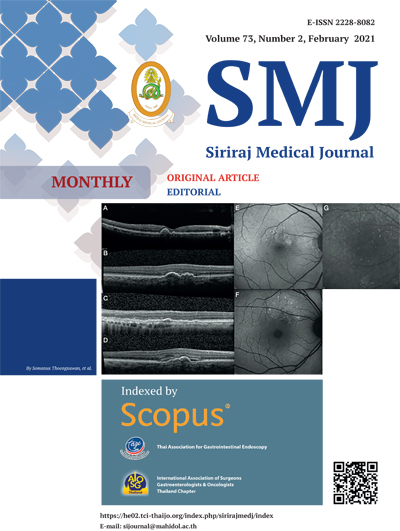Innovative Device for Enhancing Physical Distancing in the COVID-19 Situation
DOI:
https://doi.org/10.33192/Smj.2021.10Keywords:
physical distancing, COVID-19, Innovative deviceAbstract
Objective: During the COVID-19 pandemic, physical distancing is one of the non-pharmaceutical measures that was recommended to reduce COVID-19 spread. Studies regarding physical distancing intervention and its effectiveness in Thailand have rarely been reported. This study aimed to evaluate physical distancing compliance among newly developed media interventions.
Methods: We used accidental sampling and the data collection method was observation via CCTV, at the university canteen. Three interventions, including an attractive picture, a flashing red-light, a speech alarm sound and the conventional intervention were employed to 400 customers. Each intervention was monitored in non-prime hours.
Results: The quasi-experimental study of 400 participants, the success rate of developed intervention including a flashing red light (6.0%, p = 0.279), an attractive picture (5.0%, p = 0.445) and a speech alarm sound (4.0%, p = 0.683) in promoting physical distancing compliance was not statistically significant from conventional intervention (2.0%). However, there was a statistically significant enhancement of physical compliance in some marking positions in our intervention.
Conclusion: The effectiveness of the innovative device was not statistically significant to enhance physical distancing compliance among customers of the university canteen. The compliance statistically significantly enhances in some marking points. The integration of the use of media into conventional interventions provides an alternative for enhancing physical distancing.
Published
How to Cite
Issue
Section
License
Copyright (c) 2021 Siriraj Medical Journal

This work is licensed under a Creative Commons Attribution-NonCommercial-NoDerivatives 4.0 International License.
Authors who publish with this journal agree to the following conditions:
Copyright Transfer
In submitting a manuscript, the authors acknowledge that the work will become the copyrighted property of Siriraj Medical Journal upon publication.
License
Articles are licensed under a Creative Commons Attribution-NonCommercial-NoDerivatives 4.0 International License (CC BY-NC-ND 4.0). This license allows for the sharing of the work for non-commercial purposes with proper attribution to the authors and the journal. However, it does not permit modifications or the creation of derivative works.
Sharing and Access
Authors are encouraged to share their article on their personal or institutional websites and through other non-commercial platforms. Doing so can increase readership and citations.















